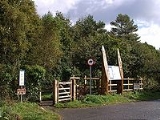
Petrockstow railway station
Encyclopedia
Petrockstow railway station was a station serving the village of Petrockstowe
in West Devon, which is about one mile away. The station was, throughout its passenger-carrying life from 1925 to 1965, spelt without the final "e" of the village name.
The railway was originally built as a narrow-gauge freight line to carry ball clay
to Torrington
from the Marland and Meeth clay pits. The Torrington and Marland Railway
then became the basis of the northern section of the North Devon and Cornwall Junction Light Railway, which opened in 1925 and remained a private line until finally becoming part of the Southern Region of British Railways
in 1948.
A victim of Beeching
, the line closed to passengers in 1965 but it remained open for freight trains from the Meeth quarries which passed into the rail network through Barnstaple
and Torrington
until 1982.
Petrockstowe
First mentioned in the Domesday Book Petrockstowe is a small village in the Devon district of Torridge in Northern Devon. It is near the end of the Tarka Trail. Its population has fluctuated between 400 and 600...
in West Devon, which is about one mile away. The station was, throughout its passenger-carrying life from 1925 to 1965, spelt without the final "e" of the village name.
The railway was originally built as a narrow-gauge freight line to carry ball clay
Ball clay
Ball clays are kaolinitic sedimentary clays, that commonly consist of 20-80% kaolinite, 10-25% mica, 6-65% quartz. Localized seams in the same deposit have variations in composition, including the quantity of the major minerals, accessory minerals and carbonaceous materials such as lignite...
to Torrington
Torrington railway station
Torrington station was a west country railway station that dispatched trains to Bideford and Barnstaple, as well as being a terminus for the North Devon and Cornwall Junction Light Railway line to Halwill in North Devon. The station was closed for regular passenger services in 1965 but special...
from the Marland and Meeth clay pits. The Torrington and Marland Railway
Torrington and Marland Railway
The Torrington and Marland Railway was a narrow gauge railway built to carry clay from the quarries at Clay Moor to Torrington in north Devon.- History :...
then became the basis of the northern section of the North Devon and Cornwall Junction Light Railway, which opened in 1925 and remained a private line until finally becoming part of the Southern Region of British Railways
Southern Region of British Railways
The Southern Region was a region of British Railways from 1948. The region ceased to be an operating unit in its own right in the 1980s and was wound up at the end of 1992. The region covered south London, southern England and the south coast, including the busy commuter belt areas of Kent, Sussex...
in 1948.
A victim of Beeching
Beeching Axe
The Beeching Axe or the Beeching Cuts are informal names for the British Government's attempt in the 1960s to reduce the cost of running British Railways, the nationalised railway system in the United Kingdom. The name is that of the main author of The Reshaping of British Railways, Dr Richard...
, the line closed to passengers in 1965 but it remained open for freight trains from the Meeth quarries which passed into the rail network through Barnstaple
Barnstaple railway station
Barnstaple railway station is the terminus of a long branch line, known as the Tarka Line, north west of Exeter St Davids, in Devon.It was known as Barnstaple Junction from 1874 to 1970 as it was the junction between lines to , , and Exeter-History:...
and Torrington
Torrington railway station
Torrington station was a west country railway station that dispatched trains to Bideford and Barnstaple, as well as being a terminus for the North Devon and Cornwall Junction Light Railway line to Halwill in North Devon. The station was closed for regular passenger services in 1965 but special...
until 1982.

